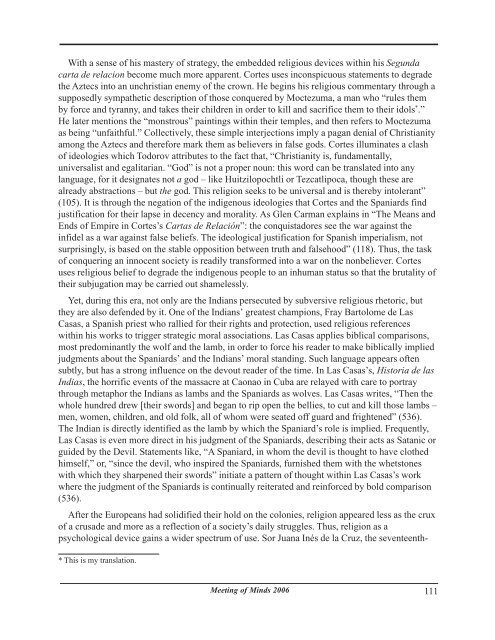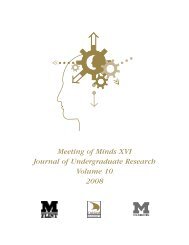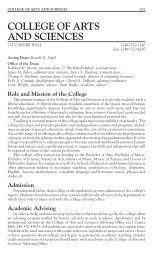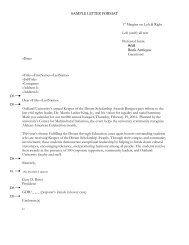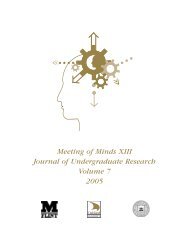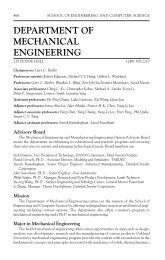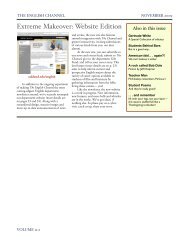MOM 2006 journal for pdf.pmd - University of Michigan-Flint
MOM 2006 journal for pdf.pmd - University of Michigan-Flint
MOM 2006 journal for pdf.pmd - University of Michigan-Flint
Create successful ePaper yourself
Turn your PDF publications into a flip-book with our unique Google optimized e-Paper software.
With a sense <strong>of</strong> his mastery <strong>of</strong> strategy, the embedded religious devices within his Segunda<br />
carta de relacion become much more apparent. Cortes uses inconspicuous statements to degrade<br />
the Aztecs into an unchristian enemy <strong>of</strong> the crown. He begins his religious commentary through a<br />
supposedly sympathetic description <strong>of</strong> those conquered by Moctezuma, a man who “rules them<br />
by <strong>for</strong>ce and tyranny, and takes their children in order to kill and sacrifice them to their idols * .”<br />
He later mentions the “monstrous” paintings within their temples, and then refers to Moctezuma<br />
as being “unfaithful.” Collectively, these simple interjections imply a pagan denial <strong>of</strong> Christianity<br />
among the Aztecs and there<strong>for</strong>e mark them as believers in false gods. Cortes illuminates a clash<br />
<strong>of</strong> ideologies which Todorov attributes to the fact that, “Christianity is, fundamentally,<br />
universalist and egalitarian. “God” is not a proper noun: this word can be translated into any<br />
language, <strong>for</strong> it designates not a god – like Huitzilopochtli or Tezcatlipoca, though these are<br />
already abstractions – but the god. This religion seeks to be universal and is thereby intolerant”<br />
(105). It is through the negation <strong>of</strong> the indigenous ideologies that Cortes and the Spaniards find<br />
justification <strong>for</strong> their lapse in decency and morality. As Glen Carman explains in “The Means and<br />
Ends <strong>of</strong> Empire in Cortes’s Cartas de Relación”: the conquistadores see the war against the<br />
infidel as a war against false beliefs. The ideological justification <strong>for</strong> Spanish imperialism, not<br />
surprisingly, is based on the stable opposition between truth and falsehood” (118). Thus, the task<br />
<strong>of</strong> conquering an innocent society is readily trans<strong>for</strong>med into a war on the nonbeliever. Cortes<br />
uses religious belief to degrade the indigenous people to an inhuman status so that the brutality <strong>of</strong><br />
their subjugation may be carried out shamelessly.<br />
Yet, during this era, not only are the Indians persecuted by subversive religious rhetoric, but<br />
they are also defended by it. One <strong>of</strong> the Indians’ greatest champions, Fray Bartolome de Las<br />
Casas, a Spanish priest who rallied <strong>for</strong> their rights and protection, used religious references<br />
within his works to trigger strategic moral associations. Las Casas applies biblical comparisons,<br />
most predominantly the wolf and the lamb, in order to <strong>for</strong>ce his reader to make biblically implied<br />
judgments about the Spaniards’ and the Indians’ moral standing. Such language appears <strong>of</strong>ten<br />
subtly, but has a strong influence on the devout reader <strong>of</strong> the time. In Las Casas’s, Historia de las<br />
Indias, the horrific events <strong>of</strong> the massacre at Caonao in Cuba are relayed with care to portray<br />
through metaphor the Indians as lambs and the Spaniards as wolves. Las Casas writes, “Then the<br />
whole hundred drew [their swords] and began to rip open the bellies, to cut and kill those lambs –<br />
men, women, children, and old folk, all <strong>of</strong> whom were seated <strong>of</strong>f guard and frightened” (536).<br />
The Indian is directly identified as the lamb by which the Spaniard’s role is implied. Frequently,<br />
Las Casas is even more direct in his judgment <strong>of</strong> the Spaniards, describing their acts as Satanic or<br />
guided by the Devil. Statements like, “A Spaniard, in whom the devil is thought to have clothed<br />
himself,” or, “since the devil, who inspired the Spaniards, furnished them with the whetstones<br />
with which they sharpened their swords” initiate a pattern <strong>of</strong> thought within Las Casas’s work<br />
where the judgment <strong>of</strong> the Spaniards is continually reiterated and rein<strong>for</strong>ced by bold comparison<br />
(536).<br />
After the Europeans had solidified their hold on the colonies, religion appeared less as the crux<br />
<strong>of</strong> a crusade and more as a reflection <strong>of</strong> a society’s daily struggles. Thus, religion as a<br />
psychological device gains a wider spectrum <strong>of</strong> use. Sor Juana Inés de la Cruz, the seventeenth-<br />
* This is my translation.<br />
Meeting <strong>of</strong> Minds <strong>2006</strong> 111


